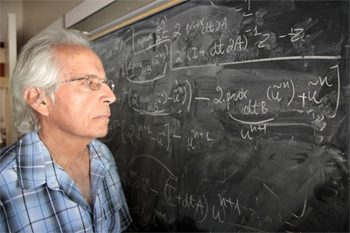One of the prizes awarded by the International Mathematical Union is the Gauss Prize for the application of mathematics. It is presented every four years at the International Congress of Mathematicians (ICM), held this year in Seoul (South Korea), where the winner was Stanley Osher (University of California Los Angeles). “Osher is a good example of an applied mathematician”, said Chi-Wang Shu (Brown University), a former PhD student and current collaborator of Osher, when the Gauss Prize was presented during the ICM on August 16th of this year. “His algorithms are based on profound abstract and technical concepts, with special emphasis on efficacy and simplicity. His work has often motivated subsequent research in mathematics. In order to extend the applications, he collaborates with engineers and other scientists from different branches”.
The prize is awarded by the IMU and the German Mathematical Society (DMV) to that scientist whose mathematical research has had a great impact outside of the discipline: in technology, finance or simply in people’s daily lives. The prize arose as a result of the budget surplus of the ICM in Berlin (1998) and was announced on April 30th, 2002, to coincide the 225th anniversary of the birth of Carl Friedrich Gauss, the Prince of mathematicians, after whom the award is named. The announcement stated that “Gauss combined scientific theory and practice in a way that no one had done before”. Three mathematicians have received the prize so far: Kiyoshi Itō (ICM Madrid 2006), Yves Meyer (ICM India 2010) y Stanley Osher, this year at the ICM Seoul 2014.

Osher has always been particularly interested in the applications of the mathematical tools he develops. As he says, “usefulness makes the beauty of mathematics even more enjoyable, although you often have no idea beforehand of what use they may have”. While he did his doctoral thesis, under the supervision of Jacob Schwartz, in the field of pure mathematics (functional analysis), he soon changed to a more applied field – numerical analysis. His early work was on the development of high resolution schemes, which have turned out to be extremely useful in the study of fluid dynamics and other related fields.
His mathematical tools are behind the animation of films from Pixar, Disney, Warner and Dreamworks, such as “Pirates of the Caribbean”, “Star Wars”, “Harry Potter” and “Terminator 3”. One of his students, Ronald Fedkiw, received a special Oscar for Scientific and Technical Achievement for the technology deriving from the so-called level set method. This method provides the means of determining how surfaces move, combine and merge in 3D, which enables different fluids, bubbles or explosions to be simulated for the cinema.
Video: Simulating fluids (Industrial Light and Magic)
Osher has also made vital contributions to image processing. His techniques for improving video images, developed in conjunction with L. Rudin, are successfully used by police forces all over the world for the apprehension of criminals. These tools have also played an important part in astronomy for improving the quality of photographs that are often dim or blurred, as well as in medicine for understanding how the shape and topology of the brain affect its function. Stanley Osher is an extraordinary mathematician whose contributions have influenced the daily lives of many people and are noticeable in the world around us. The next time you go to the cinema and see and animated film, think about the mathematics that lies behind it; it probably carries Osher’s signature.
This text is an original story of Jezebel Curbelo for the ICMAT. You can find the complete text in the Newsletter of the Institute of Mathematical Sciences (ICMAT).
Jezebel Curbelo
for ICMAT
Comments on this publication